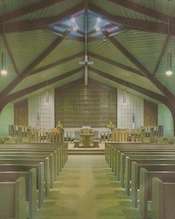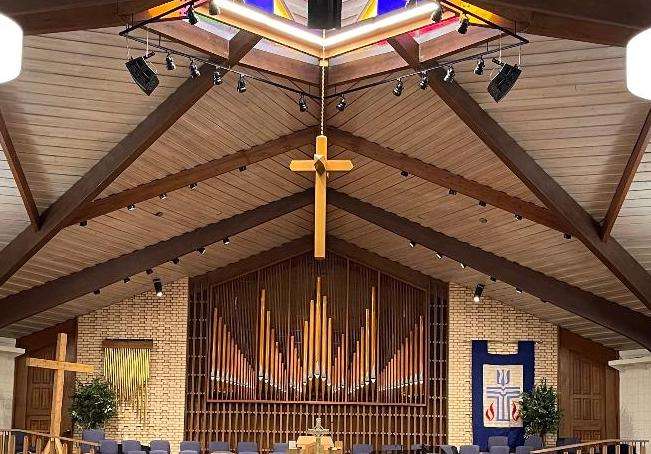Music is an integral part of our worship of God. At First Presbyterian Church, we have many giving musicians and vocalists who give of their time and talents to enhance our worship services. Some of these groups are open for congregational participation, namely: the Chancel Choir & Bell Choir. Reach out to our choir director to get involved!
Roxy Theater Organ

In 1925, the congregation of the First Presbyterian Church, Las Cruces, New Mexico purchased a parcel of land at the intersection of Las Cruces Avenue and Raymond Street, and set out to build a new church on the site. A man who lived across the street from the land, who was not a member of the congregation, was enthusiastic about the prospect of having a good neighbor. He expressed his delight to the Session of First Presbyterian Church by saying he would purchase a pipe organ and have it installed in the new church.
He had read that the Roxy Theatre in New York City was offering its pipe organ for sale. Immediately he made contact with the management of the theatre and succeeded in buying the instrument. He had it crated and shipped by ocean freighter from New York City to New Orleans. Enroute, the freighter ran into a violent storm. The crates were tossed about in the hold of the vessel, the crates burst open, and parts of the organ were scattered about and badly damaged. The vessel continued its course and docked in New Orleans. Pieces of the organ were gathered, recrated, placed on freight cars and shipped to Las Cruces.
Men in the congregation set about reconstructing the organ. They were successful. It was maintained through its years of service by laymen. Mr. Roy France, an auto mechanic, was the chief artisan. He could be seen on a Saturday afternoon sitting on a pew, cutting shoe leather, then fitting a piece into a crack.
In the early 196O’s the congregation purchased a 6 acre plot of land on Boutz Road. An architect was selected to draw up plans for a new church on the site. The question arose over the matter of moving the organ to the new church or purchasing a new instrument. As fundraising began, it became apparent there would not be enough money in the immediate future to pay for a new instrument. The Building Committee realized that the old organ would not be able to provide enough sound to fill the new, larger sanctuary.
Mr. Chester Linscheid, a member of the Building Committee, was assigned the task of finding a solution. After a long search, he found a sympathetic ear in Mr. Smith A. Gauntt, an organ builder in Denver, Colorado. Mr. Gauntt had in his shop a large supply of used wind chests, pipes, electrical equipment, keyboards and other organ parts, which he had salvaged from used organs. Mr. Linsceid asked him to solve the problem.
As construction of the sanctuary was nearing completion in 1964, Mr. Gauntt first moved the organ from the old church to the new one, then proceeded to recondition and rebuild the instrument. He installed 19 ranks of pipes. He used the old three-manual keyboard and electrical contacts, but wrapped them in a new console shell. Very little new material was used. Some of the pipes in the restored instrument were taken from theater organs, including that from the Roxy Theater, which employs high wind pressure to drive the sound from organ chambers into the theater. Other pipes came from church organs that operate at a low wind pressure to produce sounds appropriate for worship. Mr. Gauntt nicked the mouth of the pipes from church organs so they could operate on high wind pressure. These pipes then produced a dull rather than a bright sound. The assortment of pipes did not produce ideal musical sounds, but costs were also a factor.
Maintaining the instrument became a task of increasing difficulty.
The Sipe organ became the second pipe organ for the church.

In January 1975, the Worship Committee recommended to the Session the need for an Organ Committee to deal with the steadily deteriorating pipe organ. The session appointed a committee.
Six pipe organ building firms were invited to bid either on restoring the existing instrument or building a new instrument. All firms bid on a new instrument. The bids ranged from $85,025 to $130,000. Three builders of electronic organs made bids.
None of the electronic builders, whose bids were only slightly less than those of the pipe organ builders, would guarantee their instruments beyond 10 years. In contrast, the pipe organ builders claimed their instruments would last a minimum of 50 years.
It was decided that, in order to procure an organ of quality while being careful with expenditures, we would find an organ builder who would be willing to use some of the better pipe work from the old organ, a conglomerate instrument of at least three different builders. We found this man in Robert Sipe, who had worked for years with the Aoelian-Skinner Organ Company in their mechanical action department and who lived in Dallas. Mechanical action means that the organ key action is operated mechanically, rather than by electrical contacts. This type of organ is much more responsive to touch and has greater longevity.
A congregational meeting was called for January 25, 1976. The committee recommended the bid of Robert L. Sipe, Inc., of Dallas, Texas, who offered a two-manual tracker instrument with 26 stops and 35 ranks of pipes, for $109,200. The congregation approved the recommendation. Mr. Sipe had several organs under construction in 1976. It was not until the Summer of 1980 that he was able to install the instrument.
The church signed the contract with Robert Sipe, and was put on a waiting list for the instrument. Bob and his wife, Susan, came the summer of 1980 and installed the organ of almost 2,000 pipes in approximately 6 weeks. The cost of the organ was $109,200. Today(2023) the organ is almost 43 years old. Over the years our instrument has been regularly tuned and maintained primarily by organ technician and builder Grahame Davis from Tucson.
